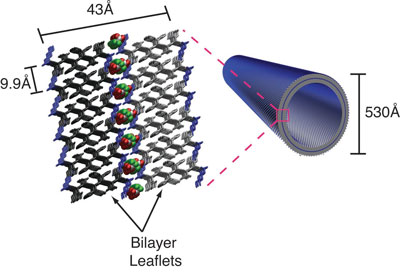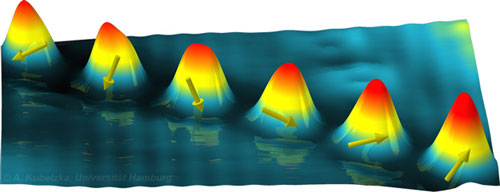 Emory scientists have discovered that simple peptides can organize into bi-layer membranes. The finding suggests a 'missing link' between the pre-biotic Earth's chemical inventory and the organizational scaffolding essential to life.
Emory scientists have discovered that simple peptides can organize into bi-layer membranes. The finding suggests a 'missing link' between the pre-biotic Earth's chemical inventory and the organizational scaffolding essential to life.
May 6th, 2010
Read more
NanoSight invites registration today for an interactive webinar on high-resolution nanoparticle characterization: 'Nanoparticle Tracking Analysis - Complementing DLS for more Complex Dispersions'.
May 6th, 2010
Read more
Devices that can mimic Superman's X-ray vision and see through clothing, walls or human flesh are the stuff of comic book fantasy, but a group of scientists at Boston University has taken a step toward making such futuristic devices a reality.
May 6th, 2010
Read more
The symposium will cover various aspects of modern Raman microscopy and will provide an introduction to Raman spectroscopy in general as well as operational principles and instrumentation relevant to the techniques.
May 6th, 2010
Read more
Dr. Hood, Co-founder and President of the Institute for Systems Biology, Seattle, is one of the world's leading scientists in systems biology, biotechnology, immunology, and genomics.
May 6th, 2010
Read more
Neue Materialien im Nanomassstab, schnellere Produktionsmethoden und neue Zulieferketten: Beim 4. COMPAMED Fruehjahrsforum am 4. Mai gab es viel Gespraechsbedarf.
May 6th, 2010
Read more
 An international team of researchers has built a chain of cobalt atoms and analysed its magnetic properties. Surprisingly, the spin sensitive measurements show that the observed form of atoms depends on its magnetic orientation.
An international team of researchers has built a chain of cobalt atoms and analysed its magnetic properties. Surprisingly, the spin sensitive measurements show that the observed form of atoms depends on its magnetic orientation.
May 6th, 2010
Read more
Researchers have devised a self-adjusting remote-control system that can place a dot 6 nanometers long to within 45 nm of any desired location. That's the equivalent of picking up golf balls around a living room and putting them on a coffee table - automatically, from 100 miles away.
May 6th, 2010
Read more
An international team of researchers has found a way to make random numbers truly random.
May 6th, 2010
Read more
An EU-funded team of scientists from Cardiff University in the UK has successfully fired photons into a small tower of semiconducting material. The work could eventually lead to the development of faster computers.
May 6th, 2010
Read more
Laser interference lithography can produce very high-resolution nano-scale surface patterns at low cost, and now European researchers have made important breakthroughs in the area.
May 6th, 2010
Read more
 Because the 'coffee ring' phenomenon occurs with many liquids after they have evaporated, scientists have suggested that such rings can be used for examining blood or other fluids for disease markers by using biosensing devices.
Because the 'coffee ring' phenomenon occurs with many liquids after they have evaporated, scientists have suggested that such rings can be used for examining blood or other fluids for disease markers by using biosensing devices.
May 5th, 2010
Read more
University of British Columbia researchers have cast artificial proteins into a new solid biomaterial that very closely mimics the elasticity of muscle.
May 5th, 2010
Read more
New research by scientists at The University of Texas Health Science Center at Houston (UTHealth) and The University of Texas M. D. Anderson Cancer Center could make it easier for patients to use a family of promising experimental cancer therapeutics known as small interfering RNA (siRNA).
May 5th, 2010
Read more
This report presents the information obtained from the Questionnaire on Regulatory Regimes on Manufactured Nanomaterials. 24 legislations from 9 jurisdictions were analyzed. The report summarizes objectives and activities covered by each legislation, as well as information on registration/notification, assessment and management of substances which are either pre-market or already in commerce. It also provides a number of legislative features identified in the legislations for consideration when amending or drafting legislation for regulatory oversight of nanomaterials and their products.
May 5th, 2010
Read more
In September 2009, the OECD held a workshop on Risk Assessment of Manufactured Nanomaterials in a Regulatory Context. This is the report of the workshop.
May 5th, 2010
Read more
 Emory scientists have discovered that simple peptides can organize into bi-layer membranes. The finding suggests a 'missing link' between the pre-biotic Earth's chemical inventory and the organizational scaffolding essential to life.
Emory scientists have discovered that simple peptides can organize into bi-layer membranes. The finding suggests a 'missing link' between the pre-biotic Earth's chemical inventory and the organizational scaffolding essential to life. 


 Subscribe to our Nanotechnology News feed
Subscribe to our Nanotechnology News feed